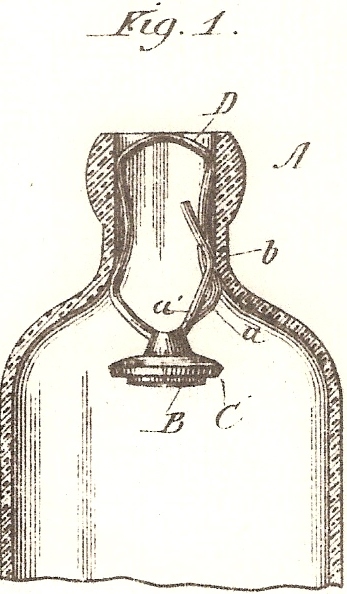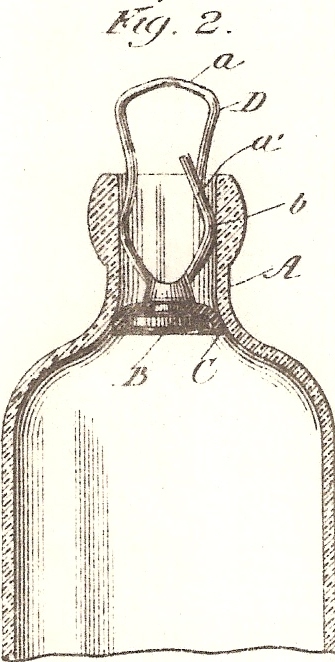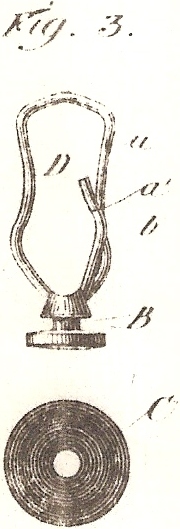Joseph Alsfaffer Bottle Stopper



Joseph
Alsfasser’s patent application was filed March 5, 1885 and specified:
I, Joseph Alsfasser…
The object of the invention is to improve the
construction of the bail to which internal stoppers are secured, thereby
rendering their holding powers greater…the invention consists of the
novel construction and arrangement of such bail and its combination with
the stopper and bottle…
Figure 1 is a vertical section of the neck of a bottle
provided with my improvement, and showing the bottle open; Fig. 2, a
similar view with the bottle closed, and Fig. 3 a detail of the bail and
stopper. Like letters refer
to like parts in each view.
A represents the
neck of a bottle, and, as is usual, is slightly contracted at a point
between its upper or outer end and its lower end, of which the bottle
proper is a continuation.
The stopper consists of a piece,
B, provided with two flanges separated by a suitable groove, into
which a rubber disk, C, is
inserted and held. The part
B is secured by soldering or
otherwise to the bail D, now to be referred to.
Bail D is
formed of spring-wire, and is of the form shown in the drawings.
The wire of which the bail is formed is, as shown, bent until its
two free ends pass each other, thus forming a complete loop.
The sides of this loop are bent inwardly to conform to the shape
of the contracted portion of the neck
A, while the upper and lower
portions are bent outwardly – the former to give a hold for a hook used
in operating the stopper…and the latter to receive the stopper.
It will thus be seen that the stopper is secured to the bail
intermediate of its free ends, and that both of such free ends are
adapted to press against the neck of the bottle.
It will also be understood that the bail may be formed
of two separate pieces, a a’,
as marked in Fig. 3…the part a’,
whether the bail is of one piece or two, is bent to form a shoulder at
b’, to correspond with a
similar shoulder formed in the bail.
The manner of using the device is as follows:
The user receives the bottle filled and closed, with
the stopper in the position shown in Fig. 2, it being held in that
position by the expansion of the spring-bail after it passes the
contracted portion of the neck.
To open the bottle, pressure is applied to the top of the bail,
generally by striking it against the counter or other convenient place.
This force drives the parts to the position shown in Fig. 1,
wherein, as shown, the top of the bail is below the upper end of the
neck, the stopper carried from its seat, and the parts held in position
by the contraption in the neck being encircled and clasped by the bail.
After the bottle has been refilled by the bottler, the stopper is
carried back to its seat by inserting a hook under the top of the bail
and drawing it upwardly.
What I claim is…The combination, with a bottle and a
spring-bail formed with two free ends, situated upon the same side of
the loop formed by the bail, of a stopper secured to such bail
intermediate of the ends.
Comments:
Although Joseph Alsfaffer's patent application doesn’t
include specific references to Charles G. Hutchinson’s bottle stopper
patents, the similarities are obvious.
There is no evidence he achieved any marketing success with his
closure.
 HutchBook.com
HutchBook.com